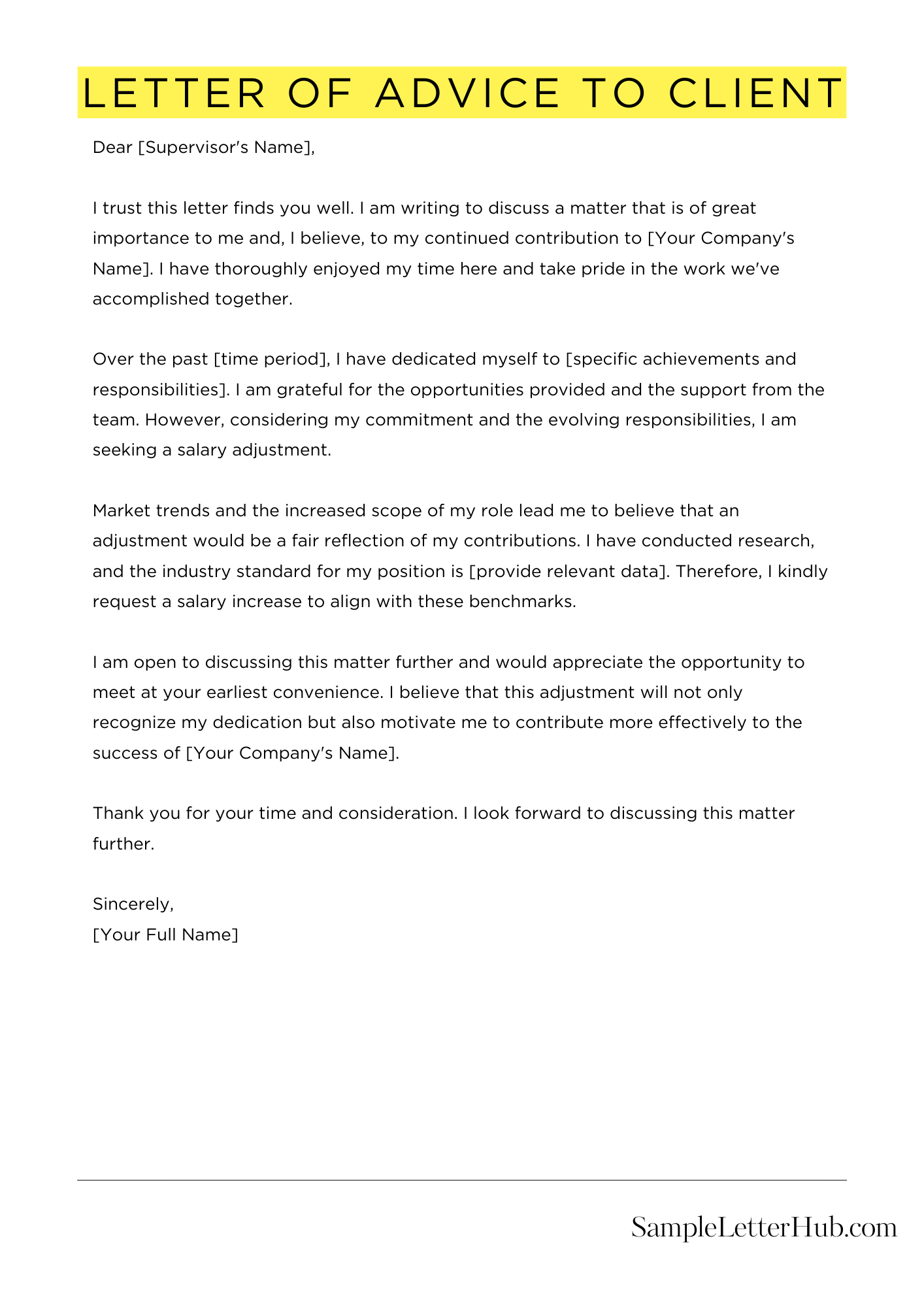Letter of Advice to Client is a formal document that provides professional guidance and recommendations to clients. It outlines specific actions, strategies, or solutions to address their legal, financial, or business matters.
In this blog article, we will share a collection of templates, examples, and samples of Letter of Advice to Client. These resources will serve as a valuable guide, providing you with a starting point and inspiration for crafting your own letters.
Letter of Guidance for Valued Client
Dear [Client Name],
I hope this letter finds you well. I am writing to offer my advice on [specific topic] as per our recent discussion.
Based on my experience and understanding of your business, I believe that [brief advice]. This strategy has proven successful in similar situations and can potentially [expected outcome].
To implement this effectively, I recommend [specific steps]. It is important to [emphasize key point]. Additionally, consider [alternative approach].
I understand that every business is unique, so I am available to discuss this further and tailor the advice to your specific needs. Please feel free to reach out to me if you have any questions or require additional support.
I am confident that by implementing these suggestions, you can [expected benefits]. I am committed to your success and look forward to seeing your business thrive.
Sincerely,
[Your Name]

How to Write a Letter of Advice to a Client
As a professional, you may find yourself in a situation where you need to provide advice to a client. Whether it’s regarding a business decision, a legal matter, or a personal issue, crafting an effective letter of advice is crucial for conveying your expertise and assisting your client in making informed choices.
1. Establish a Clear Purpose
Before you begin writing, determine the specific purpose of your letter. What advice do you intend to provide? What outcome do you hope to achieve? Having a clear purpose will guide the structure and content of your letter.
2. Use Formal Language
Adopt a formal tone throughout your letter. Use precise and professional language, avoiding colloquialisms or slang. This conveys respect for your client and the importance of the advice you’re providing.
3. State Your Expertise
Briefly mention your credentials or experience that qualifies you to provide advice on the matter at hand. This establishes your credibility and reassures your client that they’re receiving guidance from a knowledgeable source.
4. Provide Specific Advice
Clearly articulate your advice, supported by relevant facts, examples, or research. Use specific language and avoid vague or general statements. Ensure that your advice is actionable and tailored to your client’s unique situation.
5. Address Potential Concerns
Anticipate any potential concerns or objections your client may have. Address these concerns in a thoughtful and empathetic manner. By acknowledging and addressing their doubts, you demonstrate that you’ve considered their perspective and are invested in their well-being.
6. Use Persuasive Techniques
Employ persuasive techniques to support your advice. Use logical reasoning, provide evidence, and appeal to your client’s values or goals. By presenting a compelling case, you increase the likelihood that your client will follow your recommendations.
7. Conclude with a Call to Action
End your letter with a clear call to action. Encourage your client to take specific steps, such as scheduling a meeting, implementing your advice, or seeking further assistance. By providing a clear path forward, you empower your client to make informed decisions and take action.
FAQs about Letter Of Advice To Client
What is a letter of advice to a client?
A letter of advice to a client is a formal document that provides professional guidance and recommendations to a client on a specific matter.
What are the key elements of a letter of advice to a client?
The key elements of a letter of advice to a client typically include an introduction, a statement of the issue, an analysis of the issue, recommendations, and a conclusion.
When should a letter of advice to a client be used?
A letter of advice to a client should be used when a client seeks professional guidance on a specific matter and the matter is complex or requires specialized knowledge.
What are the benefits of using a letter of advice to a client?
The benefits of using a letter of advice to a client include providing the client with clear and concise guidance, documenting the advice provided, and protecting the professional from liability.
What are the potential risks of using a letter of advice to a client?
The potential risks of using a letter of advice to a client include the client misinterpreting the advice, the client not following the advice, and the advice being used against the professional in a legal proceeding.

